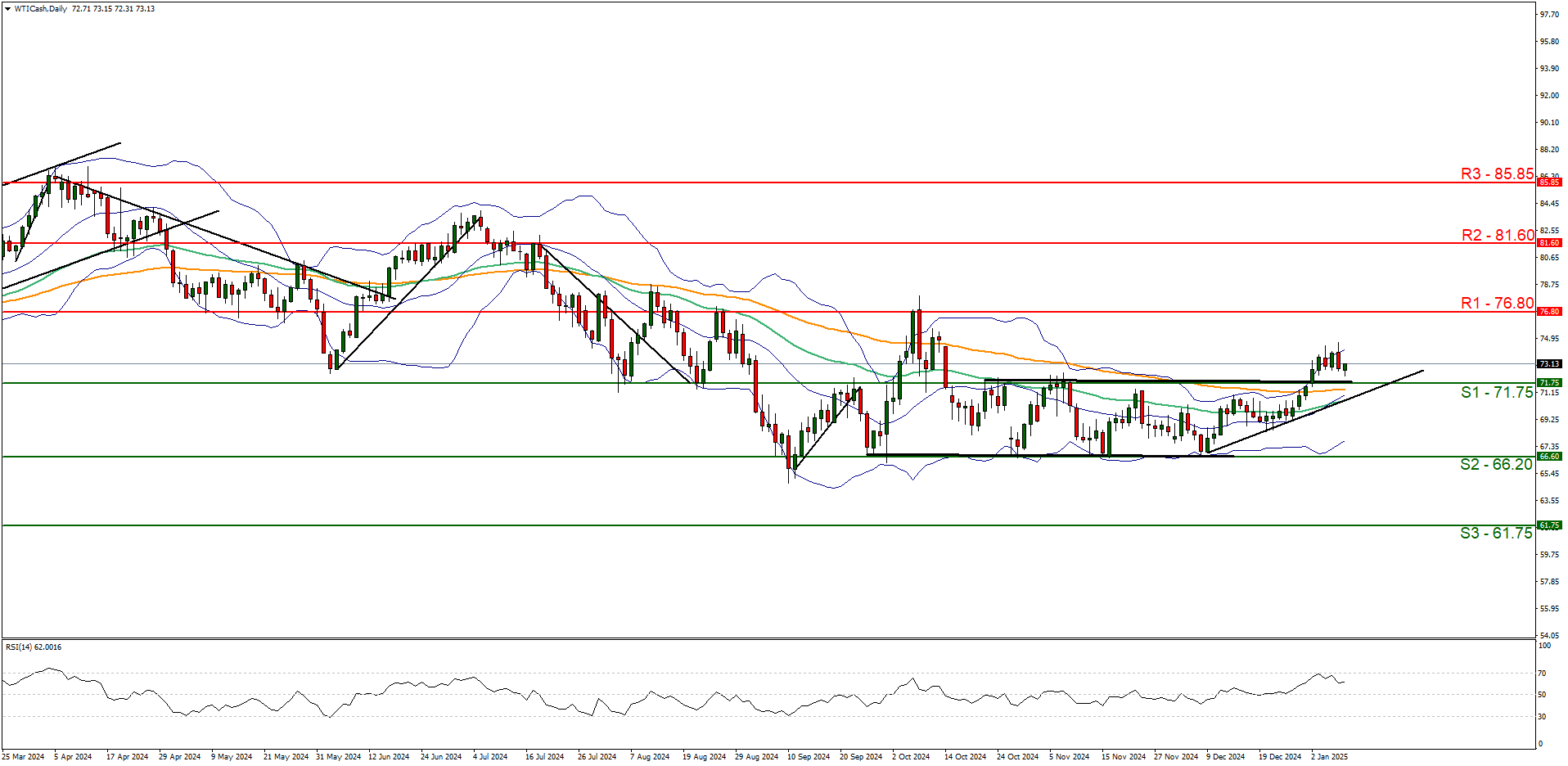Oil prices appear to have moved higher with the start of the New Year. Today we are to take a look at the recent executive order signed by Biden, the reduction of Saudi oil exports to China and finish of with the data of the US oil market. For a rounder view, we are to conclude the report with a technical analysis of WTI’s daily chart.
Biden’s last HOORAH for the climate activists
On the 6th of January, president Biden signed an executive order which would withdraw certain areas of the United States Outer Continental Shelf from oil or Natural gas leasing. Essentially president Biden has announced an offshore oil and gas drilling ban for areas which are part of the Northen Bering Sea Climate Resilience Area amongst other parts. The outgoing president has used the 70-year-old Outer Continental Shelf Lands Act which allows presidents to remove areas from mineral leasing and drilling but does not allow presidents the legal authority to overturn prior bans according to a 2019 court ruling. The announcement may have sparked concern about potential limitations for the incoming administration which aims to increase energy production in the US as seen by Trump’s moto of “drill baby drill”. Moreover, the incoming president for his part has vowed to “revoke the offshore oil, gas drilling ban in vast areas on day one”, which may be slightly optimistic as it may require congressional approval in order to be overturned, implying that it cannot be ‘undone’ immediately. Nonetheless, President Trump has also stated per Reuters that his administration would open up oil and gas development in the Artic National Wildlife Refuge and may take the matter to court if necessary, per Reuters. Overall, should President-elect Trump manage to quickly overturn President Biden’s executive order, in addition to quickly granting oil drilling permits, it may imply that the US oil production levels could increase in the near future. In turn the implications of an increase in supply, could weigh on oil prices as production levels could exceed the current oil demand in the US.
Saudi exports to China to decrease
According to Reuters, Saudi Arabia’s crude oil supply to China is set to decline in February from the prior month. The report by Reuters stated that Saudi Aramco will ship about 43.5 million barrels to China in February which would be lower than last month’s figure of 46 million barrels. The report by Reuters, tends to amplify our repeated concerns in regards to the Chinese economy. We have maintained the belief that the Chinese economy may continue facing hardships in 2025. Aiding our aforementioned hypothesis was the release of China’s NBS and Caixin manufacturing PMI figures for December which were released last week and came in lower than expected. In particular, both figures are veering dangerously close to contraction territory. Nonetheless, the implications of reduced oil demand from China, the world’s largest oil imported, may be concerning for oil prices, as a continued reduction of demand from China, could lead to downwards pressures on oil prices.
The data of the US Oil market
Starting with the US oil market we note that over the holidays, the Baker Hughes indicator showed that the number of active oil rigs in the US was reduced by one to 482. The release signalled that the increase of active US oil rigs was halted, which could also be perceived as an indication a slack in oil demand in the US. Nonetheless, this Tuesday the API weekly crude oil inventories figure was released showcasing a considerable drawdown of -4.022 million barrels in US oil inventories. The release implied a continued tightness of the US oil market for a fourth week in a row which may be perceived as bullish for oil prices as aggregated oil demand surpassed production levels once again. However, the EIA on Wednesday also reported a drawdown -0.959 million barrels, which was lower than the expected drawdown of -1.8 million barrels. The lower-than-expected drawdown may imply that production levels may be meeting the current oil demand in the US and thus should they exceed demand levels, they could weigh on oil prices. Nonetheless, generally speaking the demand for oil in the US has once again surpassed oil production levels and thus may have aided oil prices during the week. However, should that narrative change in the coming week, it may have the opposite effect on oil prices.
Technical analysis
WTI cash daily chart
Support: 71.75 (S1), 66.20 (S2), 61.75 (S3).
Resistance: 76.80 (R1), 81.60 (R2), 85.85 (R3).
WTI appears to be generally moving in an upwards fashion. We opt for a bullish outlook for the commodity’s price and supporting our case is the RSI indicator below our chart which currently registers a figure above 60, implying a bullish market sentiment in addition to the upwards moving trendline which was incepted on the 9th of December 2024. For our bullish outlook to continue we would require the commodity’s price to remain above the 71.75 (S1) support level, in addition to a break above the 76.80 (R1) resistance line, with the next possible target for the bulls being the 81.60 (R2) resistance level. On the flip side for a sideways bias, we would require the commodity’s price to remain confined between the 71.75 (S1) support level and the 76.80 (R1) resistance line. Lastly, for a sideways bias we would require the commodity’s price to clearly break below our 71.75 (S1) support level, with the next possible target for the bears being the 66.20 (S2) support line.
CFDs are complex instruments and come with a high risk of losing money rapidly due to leverage. 69.80% of retail investor accounts lose money when trading CFDs with this provider. You should consider whether you understand how CFDs work and whether you can afford to take the high risk of losing your money. Our services include products that are traded on margin and carry a risk of losing all your initial deposit. Before deciding on trading on margin products you should consider your investment objectives, risk tolerance and your level of experience on these products. Margin products may not be suitable for everyone. You should ensure that you understand the risks involved and seek independent financial advice, if necessary. Please consider our Risk Disclosure. IronFX is a trade name of Notesco Limited. Notesco Limited is registered in Bermuda with registration number 51491 and registered address of Nineteen, Second Floor #19 Queen Street, Hamilton HM 11, Bermuda. The group also includes CIFOI Limited with registered office at 28 Irish Town, GX11 1AA, Gibraltar.
Recommended Content
Editors’ Picks

Gold sits at fresh record high above $3,300 as US Dollar wilts on trade woes
Gold price remains within a striking distance of new record highs above $3,300 on Wednesday. Persistent worries about the escalating US-China trade war and US recession fears revive brroad US Dollar downtrend, boosting the traditional safe-haven Gold ahead of Fed Powell's speech.

EUR/USD holds firm above 1.1350 amid renewed US Dollar weakness
EUR/USD is storngly bid above 1.1350 in European trading on Wednesday. The pair draws support from a fresh round of selling in the US Dollar amid persistent fears over US-China trade war and a lack of progress on EU-US trade talks. US consumer data and Powell speech are in focus.

GBP/USD hangs close to fresh 2025-high above 1.3250 after UK CPI data
GBP/USD holds its six-day winning streak and stays close to its highest level since October above 1.3250 in the European session on Wednesday. The data from the UK showed that the annual CPI inflation softened to 2.6% in March from 2.8% in February but had little impact on Pound Sterling.

BoC set to leave interest rate unchanged amid rising inflation and US trade war
All the attention is expected to be on the Bank of Canada this Wednesday as market experts widely anticipate the central bank to maintain its interest rate at 2.75%, halting seven consecutive interest rate cuts.

Future-proofing portfolios: A playbook for tariff and recession risks
It does seem like we will be talking tariffs for a while. And if tariffs stay — in some shape or form — even after negotiations, we’ll likely be talking about recession too. Higher input costs, persistent inflation, and tighter monetary policy are already weighing on global growth.

The Best brokers to trade EUR/USD
SPONSORED Discover the top brokers for trading EUR/USD in 2025. Our list features brokers with competitive spreads, fast execution, and powerful platforms. Whether you're a beginner or an expert, find the right partner to navigate the dynamic Forex market.
